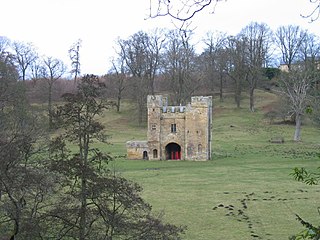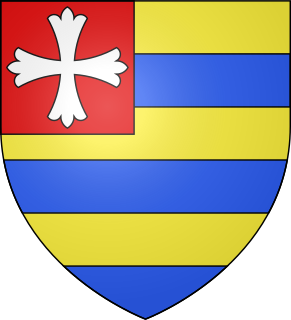
Alnwick Castle is a castle and country house in Alnwick in the English county of Northumberland. It is the seat of His Grace The 12th Duke of Northumberland, built following the Norman conquest and renovated and remodelled a number of times. It is a Grade I listed building and as of 2012 received over 800,000 visitors per year.

Viscount de Vesci, of Abbeyleix in the Queen's County, now called County Laois, is a title in the Peerage of Ireland. It was created in 1776 for Thomas Vesey, 1st Viscount de Vesci & 2nd Baron Knapton. The title Baron Knapton was created in the Peerage of Ireland in 1750 for the first Viscount's father, John Vesey, 1st Baron Knapton & 2nd Baronet, who had earlier represented Newtownards in the Irish House of Commons. The Baronetcy, of Abbeyleix in the Queen's County, was created in the Baronetage of Ireland on 28 September 1698 for the first Baron's father Reverend Thomas Vesey, Bishop of Killaloe (1713–1714) and Bishop of Ossory (1714–1730).

Alnwick Abbey was founded as a Premonstratensian monastery in 1147 by Eustace fitz John near Alnwick, England, as a daughter house of Newhouse Abbey in Lincolnshire. It was dissolved in 1535, refounded in 1536 and finally suppressed in 1539. The Alnwick Abbey site is located just within Hulne Park, on the bank of the River Aln. The only visible remnant is the impressive 14th century gatehouse.

Eustace de Vesci (1169–1216) was an English lord of Alnwick Castle, and a Magna Carta surety. He also held lands in Sprouston, Roxburghshire, Scotland as brother in-law to King Alexander II of Scotland. Eustace was a leader during the Barons' War in 1215 and was killed while undertaking a siege of Barnard Castle in 1216.

Hugh de Balliol, Lord of Bywell, Barnard Castle and Gainford, was a 12th and 13th century nobleman. He was the son of Eustace de Balliol and Petronilla FitzPiers. Balliol was a supporter of King John of England during the Barons Wars of 1215-17.
Eustace fitz John was a powerful magnate in northern England during the reigns of Henry I, Stephen and Henry II. From a relatively humble background in the south-east of England, Eustace made his career serving Henry I, and was elevated by the king through marriage and office into one of the most important figures in the north of England. Eustace acquired a great deal of property in the region, controlled Bamburgh Castle, and served jointly with Walter Espec as justiciar of the North.
North Ferriby Priory was a priory in the East Riding of Yorkshire, England, founded about 1160 by William de Vescy as a preceptory for the Knights Templar, after whose suppression it became a priory of the Austin canons. According to others, it was founded about 1200 by Lord Eustace Broomfleet de Vesci. One of the canons was usually appointed vicar of the church in North Ferriby. The priory was suppressed on 13 August 1536. The buildings have been demolished since. The priory is still remembered in the street name "Priory Avenue" and in the "Priory Rooms" of the 20th-century village hall.

John de Vesci, sometimes spelt Vescy, was a prominent 13th-century noble. He was the eldest son of William de Vesci and Agnes de Ferrers. He married firstly Mary of Lusignan and secondly Isabella de Beaumont. John died c. 1289.

de Vesci is the surname of an old Norman noble family originating from Vassy, Calvados, also known as the House of de Vesci. The first records are about Robert de Vesci, Norman conqueror and Ivo de Vesci, Lord of Alnwick. The de Vesci family held lands in England and Ireland. The family was also linked to the Scottish Crown through the marriage of Eustace de Vesci to Margaret, the oldest but illegitimate child and daughter of William the Lion by a daughter of Adam de Hythus. William de Vesci was one of the competitors for the Crown of Scotland, upon the death of Margaret, Maid of Norway in 1290.
Ivo de Vesci, sometimes spelt Vescy and first name sometimes Yves, was a prominent 11th-century noble. He obtained lands and the lordship of Alnwick in Northumberland from King William II of England. He was also given lands in Malton, Yorkshire. It is not known whether he is the son or kinsman of the Robert de Veci who participated in the Norman conquest of England and was rewarded with great estates in the counties of Northampton, Warwick and Lincoln.

Richard fitz Eustace was a prominent 12th-century noble. He was a son of Eustace fitz John and Agnes de Halton. He inherited the titles of his mother, becoming Baron of Halton, and the position of Constable of Chester. Richard died c.1163.

Beatrix de Vesci of Alnwick Castle, was an eleventh-century medieval noble lady of house de Vesci.
John Eustace Vesey, 6th Viscount de Vesci was born on 25 February 1919. He died on 13 October 1983.
Thomas Eustace Vesey, 7th Viscount de Vesci of Abbeyleix was born on 8 October 1955. He was the son of John Eustace Vesey, 6th Viscount de Vesci and the former Susan Anne Armstrong-Jones, sister of Antony Armstrong-Jones, 1st Earl of Snowdon. He sold Abbeyleix Castle, saddled with £1.5 million in death duties, in 1994 to the financier Sir David Davies. He is nephew to Antony Armstrong-Jones, 1st Earl of Snowdon and grand-nephew of Valentine Browne, 6th Earl of Kenmare.'

Sir Gilbert de Aton, 1st Baron Aton, of Ayton, Langdon, Malton and Wintringham, Yorkshire was a 13th-14th century English noble. He died c. 1342.
Baron Vesci was a title in the Peerage of England and Peerage of the United Kingdom. It existed as a feudal barony by tenure, before being created by Writ of summons to Parliament of John de Vesci in 1264 until his death in 1289. It was created a second time by writ of William de Vescy in 1295 until his death in 1297. It was created a third time in 1313 by writ of William de Vesci until his death in 1314. The title was created a fourth time by writ of Henry Bromflete, Lord Vescy in 1449 until it became extinct in 1469 upon his death. The title was created a five time for John Vesey, 4th Viscount de Vesci in 1884 until his death in 1903 when the title became extinct.










